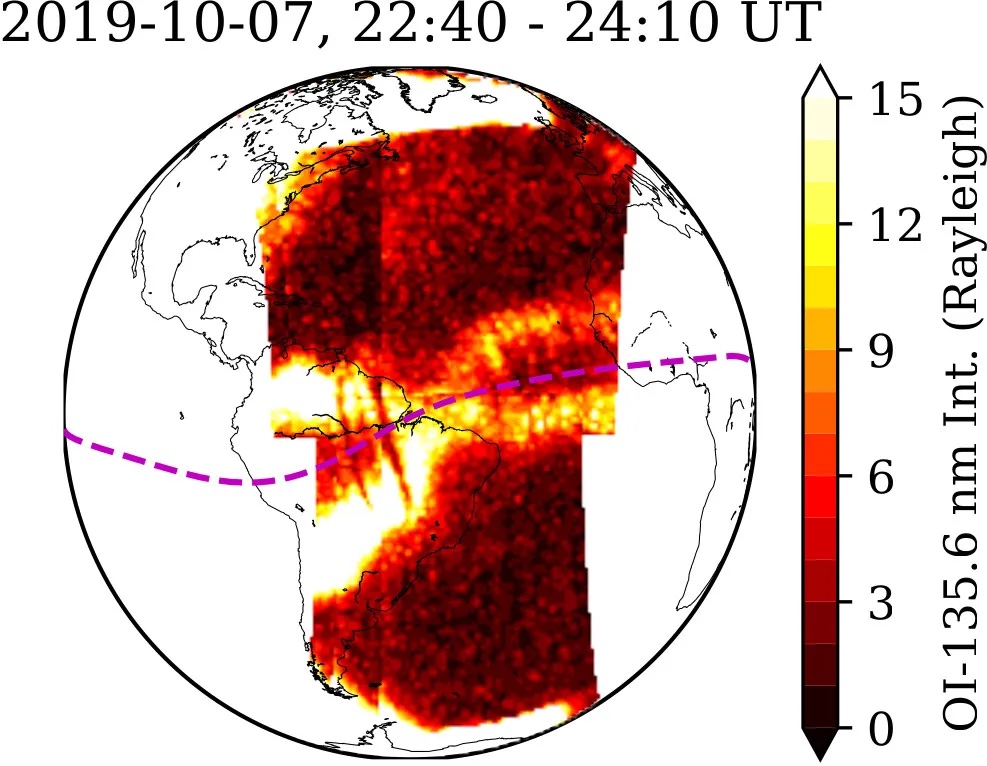A NASA satellite has discovered unexpected X- and C-shaped structures in Earth’s ionosphere, the layer of electrified gas in the planet’s atmosphere that allows radio signals to travel long distances.
the ionosphere It is an electrically charged region of the Earth’s atmosphere that exists due to the radiation emitted from it. the sun The ionosphere hits the atmosphere, and its density increases during the day as its molecules become electrically charged. This is because sunlight causes electrons to be stripped from atoms and molecules, creating plasma that enables radio signals to travel long distances. The ionosphere then becomes less dense at night—and that’s where gold comes in.
NASA’s Global Limb and Disk Observation Mission (GOLD) is a geostationary satellite that has been measuring densities and temperatures in Earth’s ionosphere since its launch in October 2018. From its geostationary orbit over the Western Hemisphere, GOLD has recently been studying two dense peaks of particles in the ionosphere, located north and south of the equator. As night falls, low-density bubbles appear within these peaks that can interfere with radio and GPS signals. However, it’s not just the waxing and waning of sunlight that affects the ionosphere—the atmosphere is also sensitive to solar storms and massive volcanic eruptions, after which the peaks can merge to form an X shape.
In its new observations, GOLD found some familiar X-shapes in the ionosphere — though there was no solar or volcanic disturbance that created them.
Related: Oops! The US Space Force may have accidentally punctured the upper atmosphere.
“Previous reports of mergers only occurred during geomagnetically disturbed conditions,” Thanks to ScarA research scientist at the University of Colorado’s Laboratory for Atmospheric and Space Physics (LASP) said in statementLaskar is the lead author of a research paper published in April in Journal of Geophysical Research: Space Physics Which described these unexpected observations.
“It’s an unexpected feature during quiet geomagnetic conditions,” he said.
This suggests that what happens in the lower atmosphere actually affects the ionosphere more than extreme solar or volcanic events.
In addition to the strange X-shapes, Gold also spotted curved C-shaped bubbles in the plasma that appeared surprisingly close together. Scientists think these bubbles take their shape and orientation based on the direction of the wind, but Gold photographed C-shaped bubbles and inverted C-shaped bubbles as far away as about 400 miles (643 kilometers). According to the researchers, it’s quite unusual for wind patterns to change so dramatically over such short distances.
“It’s really important to know why this happens,” said the Los Angeles Astrophysical Laboratory research scientist. Deepak Karanlead author of a separate research paper published in November in Journal of Geophysical Research: Space Physics“If there is a very strong vortex or shear in the plasma, it will distort the plasma over that region completely,” he said in the statement. “The signals will be completely lost if there is a strong disturbance like this.”
This is not the first time NASA has sought to understand more about the ionosphere. Most recently, a project called Atmospheric disturbances around the eclipse path The APEP investigated how reduced sunlight and temperature affect Earth’s upper atmosphere. During the annular solar eclipse on October 14 across the southwestern United States and again during Total Solar Eclipse on April 8 Across North America, NASA launched three suborbital reconnaissance rockets into the path of the eclipse to measure changes in electric and magnetic fields, density and temperature within the ionosphere. Results from the mission are still awaited.

“Beer aficionado. Gamer. Alcohol fanatic. Evil food trailblazer. Avid bacon maven.”

